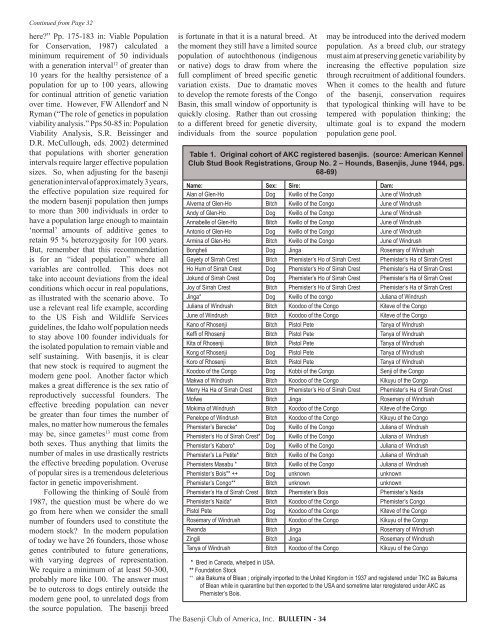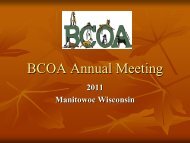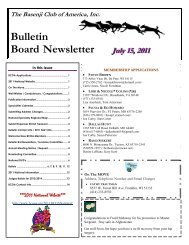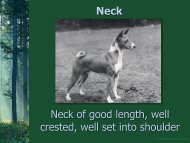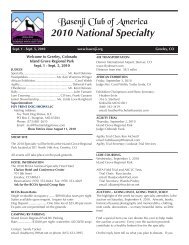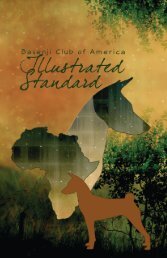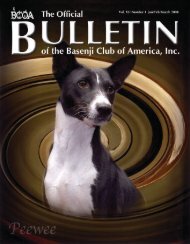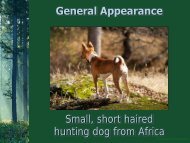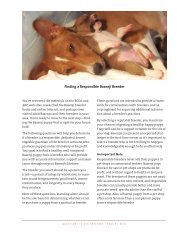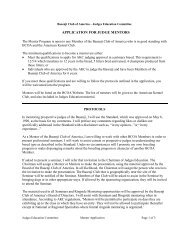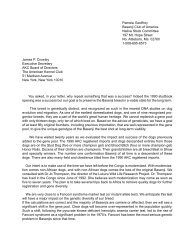BCOA Bulletin January-February-March 2007 - the Basenji Club of ...
BCOA Bulletin January-February-March 2007 - the Basenji Club of ...
BCOA Bulletin January-February-March 2007 - the Basenji Club of ...
You also want an ePaper? Increase the reach of your titles
YUMPU automatically turns print PDFs into web optimized ePapers that Google loves.
Continued from Page 32<br />
here?” Pp. 175-183 in: Viable Population<br />
for Conservation, 1987) calculated a<br />
minimum requirement <strong>of</strong> 50 individuals<br />
with a generation interval<br />
The <strong>Basenji</strong> <strong>Club</strong> <strong>of</strong> America, Inc. BULLETIN - 34<br />
12 <strong>of</strong> greater than<br />
10 years for <strong>the</strong> healthy persistence <strong>of</strong> a<br />
population for up to 100 years, allowing<br />
for continual attrition <strong>of</strong> genetic variation<br />
over time. However, FW Allendorf and N<br />
Ryman (“The role <strong>of</strong> genetics in population<br />
viability analysis.” Pps 50-85 in: Population<br />
Viability Analysis, S.R. Beissinger and<br />
D.R. McCullough, eds. 2002) determined<br />
that populations with shorter generation<br />
intervals require larger effective population<br />
sizes. So, when adjusting for <strong>the</strong> basenji<br />
generation interval <strong>of</strong> approximately 3 years,<br />
<strong>the</strong> effective population size required for<br />
<strong>the</strong> modern basenji population <strong>the</strong>n jumps<br />
to more than 300 individuals in order to<br />
have a population large enough to maintain<br />
‘normal’ amounts <strong>of</strong> additive genes to<br />
retain 95 % heterozygosity for 100 years.<br />
But, remember that this recommendation<br />
is for an “ideal population” where all<br />
variables are controlled. This does not<br />
take into account deviations from <strong>the</strong> ideal<br />
conditions which occur in real populations,<br />
as illustrated with <strong>the</strong> scenario above. To<br />
use a relevant real life example, according<br />
to <strong>the</strong> US Fish and Wildlife Services<br />
guidelines, <strong>the</strong> Idaho wolf population needs<br />
to stay above 100 founder individuals for<br />
<strong>the</strong> isolated population to remain viable and<br />
self sustaining. With basenjis, it is clear<br />
that new stock is required to augment <strong>the</strong><br />
modern gene pool. Ano<strong>the</strong>r factor which<br />
makes a great difference is <strong>the</strong> sex ratio <strong>of</strong><br />
reproductively successful founders. The<br />
effective breeding population can never<br />
be greater than four times <strong>the</strong> number <strong>of</strong><br />
males, no matter how numerous <strong>the</strong> females<br />
may be, since gametes13 is fortunate in that it is a natural breed. At may be introduced into <strong>the</strong> derived modern<br />
<strong>the</strong> moment <strong>the</strong>y still have a limited source population. As a breed club, our strategy<br />
population <strong>of</strong> autochthonous (indigenous must aim at preserving genetic variability by<br />
or native) dogs to draw from where <strong>the</strong> increasing <strong>the</strong> effective population size<br />
full compliment <strong>of</strong> breed specific genetic through recruitment <strong>of</strong> additional founders.<br />
variation exists. Due to dramatic moves When it comes to <strong>the</strong> health and future<br />
to develop <strong>the</strong> remote forests <strong>of</strong> <strong>the</strong> Congo <strong>of</strong> <strong>the</strong> basenji, conservation requires<br />
Basin, this small window <strong>of</strong> opportunity is that typological thinking will have to be<br />
quickly closing. Ra<strong>the</strong>r than out crossing tempered with population thinking; <strong>the</strong><br />
to a different breed for genetic diversity, ultimate goal is to expand <strong>the</strong> modern<br />
individuals from <strong>the</strong> source population population gene pool.<br />
Table 1. Original cohort <strong>of</strong> AKC registered basenjis. (source: American Kennel<br />
<strong>Club</strong> Stud Book Registrations, Group No. 2 – Hounds, <strong>Basenji</strong>s, June 1944, pgs.<br />
68-69)<br />
Name:<br />
Alan <strong>of</strong> Glen-Ho<br />
Alverna <strong>of</strong> Glen-Ho<br />
Andy <strong>of</strong> Glen-Ho<br />
Annabelle <strong>of</strong> Glen-Ho<br />
Sex:<br />
Dog<br />
Bitch<br />
Dog<br />
Bitch<br />
Sire:<br />
Kwillo <strong>of</strong> <strong>the</strong> Congo<br />
Kwillo <strong>of</strong> <strong>the</strong> Congo<br />
Kwillo <strong>of</strong> <strong>the</strong> Congo<br />
Kwillo <strong>of</strong> <strong>the</strong> Congo<br />
Dam:<br />
June <strong>of</strong> Windrush<br />
June <strong>of</strong> Windrush<br />
June <strong>of</strong> Windrush<br />
June <strong>of</strong> Windrush<br />
Antonio <strong>of</strong> Glen-Ho Dog Kwillo <strong>of</strong> <strong>the</strong> Congo June <strong>of</strong> Windrush<br />
Armina <strong>of</strong> Glen-Ho Bitch Kwillo <strong>of</strong> <strong>the</strong> Congo June <strong>of</strong> Windrush<br />
Bongheli Dog Jinga Rosemary <strong>of</strong> Windrush<br />
Gayety <strong>of</strong> Sirrah Crest Bitch Phemister’s Ho <strong>of</strong> Sirrah Crest Phemister’s Ha <strong>of</strong> Sirrah Crest<br />
Ho Hum <strong>of</strong> Sirrah Crest Dog Phemister’s Ho <strong>of</strong> Sirrah Crest Phemister’s Ha <strong>of</strong> Sirrah Crest<br />
Jokund <strong>of</strong> Sirrah Crest Dog Phemister’s Ho <strong>of</strong> Sirrah Crest Phemister’s Ha <strong>of</strong> Sirrah Crest<br />
Joy <strong>of</strong> Sirrah Crest Bitch Phemister’s Ho <strong>of</strong> Sirrah Crest Phemister’s Ha <strong>of</strong> Sirrah Crest<br />
Jinga* Dog Kwillo <strong>of</strong> <strong>the</strong> congo Juliana <strong>of</strong> Windrush<br />
Juliana <strong>of</strong> Windrush Bitch Koodoo <strong>of</strong> <strong>the</strong> Congo Kiteve <strong>of</strong> <strong>the</strong> Congo<br />
June <strong>of</strong> Windrush Bitch Koodoo <strong>of</strong> <strong>the</strong> Congo Kiteve <strong>of</strong> <strong>the</strong> Congo<br />
Kano <strong>of</strong> Rhosenji Bitch Pistol Pete Tanya <strong>of</strong> Windrush<br />
Keffi <strong>of</strong> Rhosenji Bitch Pistol Pete Tanya <strong>of</strong> Windrush<br />
must come from<br />
both sexes. Thus anything that limits <strong>the</strong><br />
number <strong>of</strong> males in use drastically restricts<br />
Kita <strong>of</strong> Rhosenji<br />
Kong <strong>of</strong> Rhosenji<br />
Koro <strong>of</strong> Rhosenji<br />
Koodoo <strong>of</strong> <strong>the</strong> Congo<br />
Makwa <strong>of</strong> Windrush<br />
Merry Ha Ha <strong>of</strong> Sirrah Crest<br />
M<strong>of</strong>we<br />
Mokima <strong>of</strong> Windrush<br />
Penelope <strong>of</strong> Windrush<br />
Phemister’s Berecke*<br />
Phemister’s Ho <strong>of</strong> Sirrah Crest*<br />
Phemister’s Kabero*<br />
Phemister’s La Petite*<br />
Bitch<br />
Dog<br />
Bitch<br />
Dog<br />
Bitch<br />
Bitch<br />
Bitch<br />
Bitch<br />
Bitch<br />
Dog<br />
Dog<br />
Dog<br />
Bitch<br />
Pistol Pete<br />
Pistol Pete<br />
Pistol Pete<br />
Kobbi <strong>of</strong> <strong>the</strong> Congo<br />
Koodoo <strong>of</strong> <strong>the</strong> Congo<br />
Phemister’s Ho <strong>of</strong> Sirrah Crest<br />
Jinga<br />
Koodoo <strong>of</strong> <strong>the</strong> Congo<br />
Koodoo <strong>of</strong> <strong>the</strong> Congo<br />
Kwillo <strong>of</strong> <strong>the</strong> Congo<br />
Kwillo <strong>of</strong> <strong>the</strong> Congo<br />
Kwillo <strong>of</strong> <strong>the</strong> Congo<br />
Kwillo <strong>of</strong> <strong>the</strong> Congo<br />
Tanya <strong>of</strong> Windrush<br />
Tanya <strong>of</strong> Windrush<br />
Tanya <strong>of</strong> Windrush<br />
Senji <strong>of</strong> <strong>the</strong> Congo<br />
Kikuyu <strong>of</strong> <strong>the</strong> Congo<br />
Phemister’s Ha <strong>of</strong> Sirrah Crest<br />
Rosemary <strong>of</strong> Windrush<br />
Kiteve <strong>of</strong> <strong>the</strong> Congo<br />
Kikuyu <strong>of</strong> <strong>the</strong> Congo<br />
Juliana <strong>of</strong> Windrush<br />
Juliana <strong>of</strong> Windrush<br />
Juliana <strong>of</strong> Windrush<br />
Juliana <strong>of</strong> Windrush<br />
<strong>the</strong> effective breeding population. Overuse Phemisters Masabu * Bitch Kwillo <strong>of</strong> <strong>the</strong> Congo Juliana <strong>of</strong> Windrush<br />
<strong>of</strong> popular sires is a tremendous deleterious Phemister’s Bois** ++ Dog unknown unknown<br />
factor in genetic impoverishment.<br />
Phemister’s Congo** Bitch unknown unknown<br />
Following <strong>the</strong> thinking <strong>of</strong> Soulé from Phemister’s Ha <strong>of</strong> Sirrah Crest Bitch Phemister’s Bois Phemister’s Naida<br />
1987, <strong>the</strong> question must be where do we Phemister’s Naida* Bitch Koodoo <strong>of</strong> <strong>the</strong> Congo Phemister’s Congo<br />
go from here when we consider <strong>the</strong> small Pistol Pete Dog Koodoo <strong>of</strong> <strong>the</strong> Congo Kiteve <strong>of</strong> <strong>the</strong> Congo<br />
number <strong>of</strong> founders used to constitute <strong>the</strong> Rosemary <strong>of</strong> Windrush Bitch Koodoo <strong>of</strong> <strong>the</strong> Congo Kikuyu <strong>of</strong> <strong>the</strong> Congo<br />
modern stock? In <strong>the</strong> modern population Rwanda Bitch Jinga Rosemary <strong>of</strong> Windrush<br />
<strong>of</strong> today we have 26 founders, those whose Zingili Bitch Jinga Rosemary <strong>of</strong> Windrush<br />
genes contributed to future generations, Tanya <strong>of</strong> Windrush Bitch Koodoo <strong>of</strong> <strong>the</strong> Congo Kikuyu <strong>of</strong> <strong>the</strong> Congo<br />
with varying degrees <strong>of</strong> representation.<br />
We require a minimum <strong>of</strong> at least 50-300,<br />
* Bred in Canada, whelped in USA.<br />
** Foundation Stock<br />
probably more like 100. The answer must<br />
be to outcross to dogs entirely outside <strong>the</strong><br />
modern gene pool, to unrelated dogs from<br />
<strong>the</strong> source population. The basenji breed<br />
++ aka Bakuma <strong>of</strong> Blean ; originally imported to <strong>the</strong> United Kingdom in 1937 and registered under TKC as Bakuma<br />
<strong>of</strong> Blean while in quarantine but <strong>the</strong>n exported to <strong>the</strong> USA and sometime later reregistered under AKC as<br />
Phemister’s Bois.


